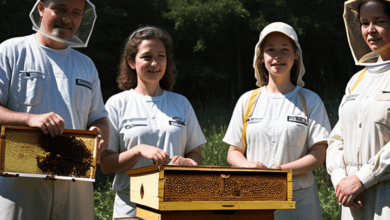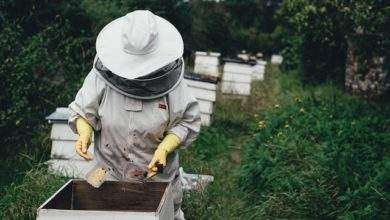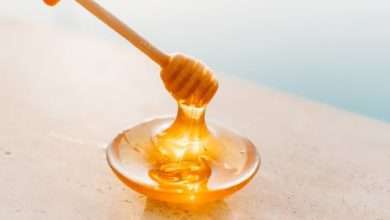Ants vs Bees – Do You Have Ants in Your Hive?
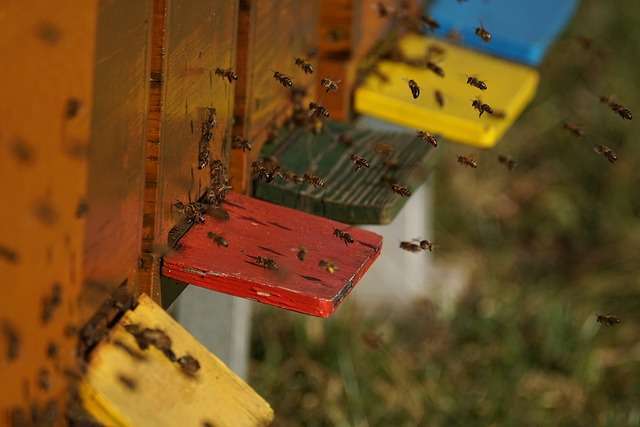
Ants and bees are both insects that belong to the order Hymenoptera. They have similar body structures, with three body parts (head, thorax, and abdomen), two antennae, and six legs.
However, their roles in the ecosystem and behavior are vastly different. While bees are known for their honey production, pollination, and colony maintenance, ants are renowned for their organized societies, resourcefulness, and ability to adapt to different environments.
Ants vs Bees: Similarities and Differences
Both ants and bees are social insects that live in colonies, with a division of labor among members. However, ants tend to have a more complex social structure, with specialized roles for different members. They have a queen, workers, and soldiers, and are more aggressive and territorial than bees. Bees, on the other hand, have a simpler social structure and are generally peaceful creatures unless provoked.
Another significant difference between ants and bees is their food preferences. Ants are omnivores and scavengers that will eat anything from dead insects to plant material. Some ant species even cultivate fungi as a food source. Bees, on the other hand, are herbivores that feed on nectar and pollen from flowers.
In terms of physical appearance, ants and bees have some distinct differences. Ants have a narrow waist and elbow-shaped antennae, while bees have a more robust, furry body and straight antennae. Bees also have transparent wings, while ants have opaque, veined wings.
Ants in Your Hive: A Potential Problem

Ants can be a nuisance to humans, but they can also pose a significant threat to honeybees. Ants in your beehives can interfere with the functioning of the hive, leading to a decrease in honey production and even the loss of your colony.
Why are Ants Attracted to Beehives?
Ants are attracted to beehives for several reasons. First, beehives provide a ready source of food for ants, especially when there is not enough food available to them in their natural habitats.
Second, ants are attracted to the sweet scent of honey, and they will go to great lengths to get a taste of it. Third, ants are attracted to the warmth and humidity that is generated by the beehive, making it an ideal home for them.
Types of Ants that Invade Beehives
Ants are common insects that can be found almost anywhere around the world. They are social insects, and like bees, they work and live in colonies.
However, unlike bees, ants are not pollinators but scavengers that feed on a variety of foods, including dead insects, sugar, and honeydew. Unfortunately, ants can also be a nuisance to beehives, as they can invade and damage them.
In this chapter, we will explore the different types of ants that commonly invade beehives and how beekeepers can prevent them.
1. Argentine Ants
- Argentine ants are invasive ants that originated from South America but have since spread throughout the world. These ants are attracted to sugary foods and have been known to invade beehives in search of honey. Argentine ants are a significant threat to beehives because they can easily overwhelm and kill weak colonies. They also kill bees by cutting off their wings and antennae.
2. Carpenter Ants
- Carpenter ants are large ants that are commonly found in North America. Unlike Argentine ants, carpenter ants do not feed on sugar but instead feed on other insects and honeydew. Carpenter ants can cause significant damage to beehives by burrowing through the wood and creating tunnels. These tunnels can weaken the structure of the beehive and make it more susceptible to other pests.
3. Fire Ants
- Fire ants are another type of invasive ant that originated from South America. These ants are known for their aggressive behavior and painful sting. Fire ants are attracted to sweet liquids like honey and have been known to invade beehives in search of food. Fire ants can be a significant threat to beehives because they can quickly kill bees and other insects.
4. Thief Ants
- Thief ants are small ants that are commonly found in North America. These ants are known for invading beehives and stealing the honey and brood. Thief ants are significant threats to beehives because they can weaken the colony and make it more susceptible to other pests and diseases.
- What Happens When Bees Encounter Ants
When bees and ants come into contact with each other, there can be a variety of outcomes. Bees and ants are both social insects, but they have very different ways of organizing their societies.
Understanding how these two insects interact can give us insight into their behavior and help us better understand the natural world.
So, what happens when bees encounter ants?
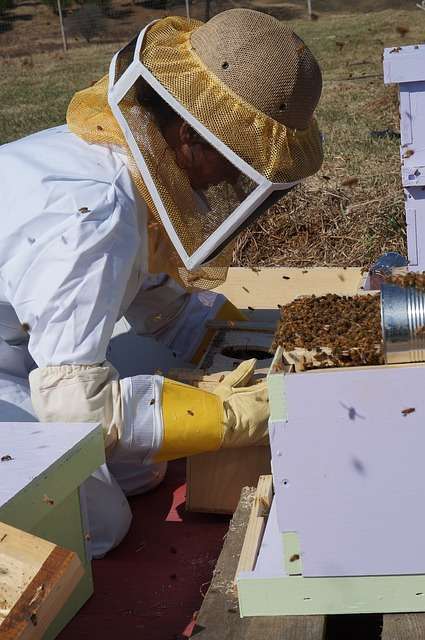
1. Ants may attack the hive
- Bees and ants share many common predators, and ants may view a beehive as a potential food source. In some cases, ants may coordinate an attack on the hive, seeking to rob the bees of their honey and larvae. If the hive is not protected, the ants may be successful in their raid.
2. Bees may fight back
- Bees are known for their aggressive behavior when they perceive a threat to their hive. When attacked by ants, bees may launch a counterattack, swarming and stinging the ants to drive them away. This can be a fierce battle, as both insects are willing to defend their nest at all costs.
3. Some bees may flee
- Not all bees are willing to engage in a fight with ants. Some may simply abandon the hive and look for a new home elsewhere. This can be a dangerous situation for the colony, as leaving the hive can put the bees at risk of being harmed by predators, such as birds or spiders.
4. Ants may steal honey and larvae
- Even if the ants are not successful in their attack on the hive, they may still be able to steal honey and larvae from the bees. Ants have been known to infiltrate beehives and carry off the honey and young, taking advantage of the bees’ busy work schedule and constant movement in and out of the hive.
5. Bees and ants may coexist peacefully
- In some cases, bees and ants are able to live in close proximity to each other without conflict. This may occur when the ants are not interested in the bees’ resources or when the bees are able to protect their hive effectively. Some species of ants even benefit from the presence of bees, as the bees’ pollination activities can improve the health of nearby plants, which can in turn benefit the ants.
How do Ants Interfere with Beehives?
Ants can cause several problems for honeybees. Firstly, they can get into the hive and eat the honey and pollen stores, which are essential for the bees’ survival, especially during the winter months. This can lead to malnourishment and starvation of the bees.
Secondly, ants can obstruct the entrance of the hive, making it difficult for bees to enter and exit, leading to a decrease in honey production. Thirdly, ants can stress bees by harassing them, causing them to waste valuable energy trying to defend the hive.
What Can You do to Prevent Ant Infestations?
If you notice ants in your beehive, it’s crucial to take action before it’s too late.
Traditional methods of ant control
The traditional approach to ant control in a beehive involves using chemical pesticides. However, these chemicals are harmful to both bees and the environment.
Chemical pesticides can contaminate the hive and the environment, posing health risks to bees and humans.
Furthermore, chemical pesticides can lead to pesticide resistance in ant populations, making them more challenging to control in the future.
Natural methods of ant control
As awareness about the adverse effects of chemical pesticides grows, more beekeepers are turning to natural methods of ant control. Natural methods not only ensure the safety of bees but also protect the environment.
One natural method of ant control entails blocking the ant entry points. Ants often enter beehives through small gaps or cracks, so beekeepers should seal such entrances with caulk.
Another method involves raising the hive off the ground to prevent ants from climbing up into the hive. Ants cannot climb slippery surfaces, so beekeepers can add a barrier of petroleum jelly around the hive legs to prevent them from reaching the hive.
A third natural method of ant control is the use of essential oils. Some essential oils, such as peppermint and cinnamon, have insecticidal properties that repel ants. Beekeepers can mix a few drops of these oils with water and spray the solution around the hive to deter ants.
Lastly, there are beehive stands that are designed to prevent ants from entering a hive, although I’ve never met anyone using them.
Conclusion
Ants and bees are fascinating creatures that play important roles in our environment. While they may have similarities in body structure, their behavior and societal structures are notably distinct.
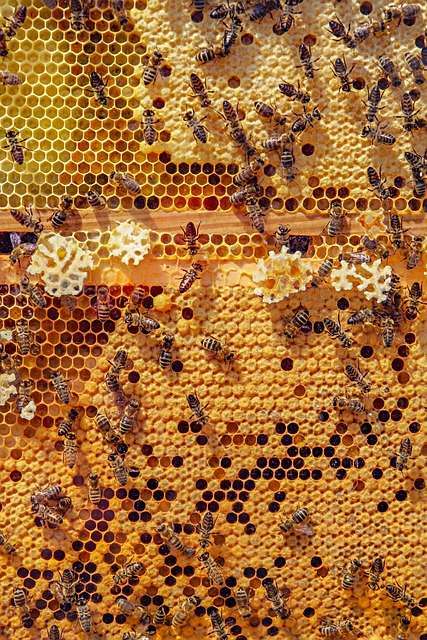
It’s possible for ants and bees to coexist, but it’s crucial to take preventive measures to avoid any potential issues, such as ants invading the hive.
By keeping your hive clean, reducing attraction, and using barriers or ant baits, you can ensure that your bee colony thrives in a safe, protected environment.
FAQ
Why do ants invade beehives?
- Ants are attracted to the sweet scent of honey and the protein-rich larvae inside the beehive. They may also be seeking shelter or water.
How can I prevent ants from invading my beehive?
- Using a beehive ant trap, such as the product we offer, can effectively deter ants from entering the hive. Placing the hive on a stand with legs coated with grease can also prevent ants from climbing up.
Can I use chemicals to deter ants from my beehive?
- It is recommended to use non-toxic methods to prevent ant infestations in beehives. Chemicals can harm the bees and affect the quality of the honey.
What should I do if I find an ant infestation in my beehive?
- Remove any ant traps or deterrents and clean the bottom board of the hive to remove any dead ants. Reapply the ant traps or deterrents.
How often should I check my beehive for ant invaders?
- It is recommended to check your beehive for ants at least once a week during peak ant season.


